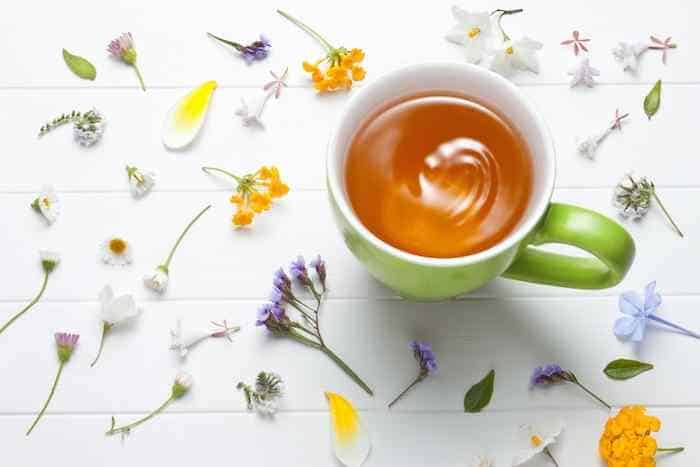Herbal tea remedies for hot flashes: soothing blends to COOL YOU DOWN naturally!
Have you ever tried to make your own tea for hot flashes? I had never brewed my own until I tried and failed to find a boxed blend that didn’t contain an added ingredient I was trying to avoid… Typical, right?
So I thought you might like to see what’s out there. I was surprised by how easy these recipes are easy to follow, and according to their creators, they might just make a difference if you’re overheating.
Remember, you should always consult your medical professional about any changes you’re going through and any treatments or alternative remedies you want to try.
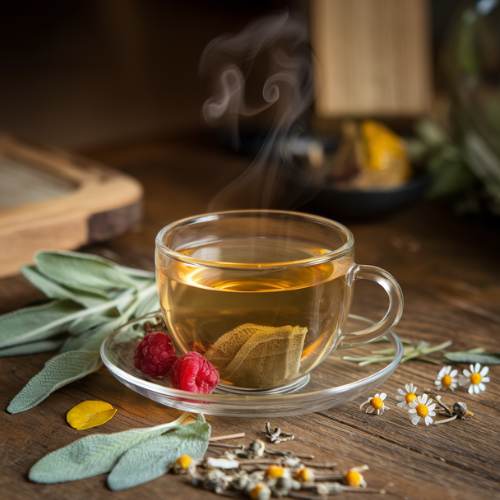
Swap Out Caffeine to Ditch Hot Flashes
Dr Rutherford and Dr Gates tell us how hot flashes cause you to heat up:
“It’s not being shown that the hot flash mechanism is coming from the brain… the brain initiates a stress response, and part of the stress response would heat the body up”
Why are women drinking tea to treat hot flashes? There are many reasons, and according to some doctors, women may find herbal treatments helpful alongside other medication.
The US National Institute on Aging recommend avoiding alcohol, spicy foods and caffeine, so you may have considered cutting down on regular caffeinated tea and coffee.
It’s not hard to find decaf alternatives these days…
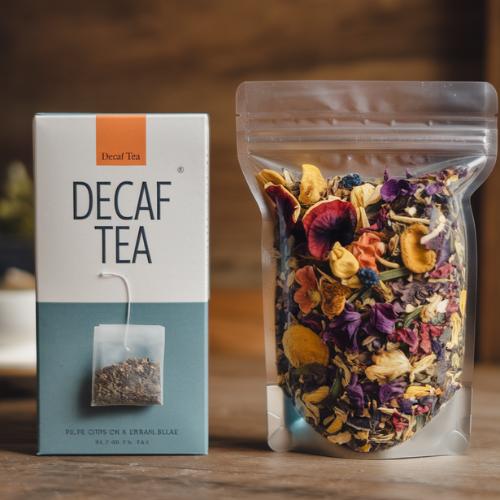
But switching to decaf might not be enough. While cutting back on caffeine can help, many women are turning to herbal teas not just as a caffeine-free alternative, but for their potential benefits in managing hot flashes.
Herbal teas, packed with natural ingredients, have been used for centuries to support women through menopause. Some of these blends are believed to have cooling, soothing effects on the body, helping to calm those sudden waves of heat and discomfort.
Whether you’re looking for a natural remedy or just a relaxing drink, these teas could be worth a sip!
Keep reading to find out which herbal ingredients may offer the most relief.
Exploring the benefits of going herbal
You could go one step further though, and drink something that might even give you another health benefit (at least, that’s what some sources say – more on that later).
Some people are wary of decaf because of the chemical-based process – does this sound like you?
UC Berkeley Wellness tell us that the chemicals used to strip out the caffeine haven’t been linked to ill effects in studies.
But what if you prefer to keep it all-natural? Or perhaps you’re not a fan of the taste of decaf and want to try something different—maybe herbal teas are the perfect option for you?
No matter your reason, herbal teas offer a natural and refreshing way to enjoy a warm drink while potentially soothing those uncomfortable hot flashes.
Sage: A Popular Tea, but Not the Only One…

Barbara Hoffman is one of the most widely recommended for treating hot flashes and their irritating buddies, night sweats.
According to New Zealand’s Healthy Online, sage can help to suppress perspiration – sounds promising, right? But does it actually work?
In a 2011 study, participants who used a sage tonic saw a reduction in their hot flashes after just four weeks. By the eighth week, two thirds saw the same results. And a 1998 trial came up with a similar outcome. So there’s definitely a potential benefit in sage when it comes to hot flashes.
Of course, that doesn’t mean it will work for everyone, but it’s interesting to see research supporting its traditional use in easing menopause symptoms.
If you’d like to give it a try, making naturopath Barbara Hoffman’s simple sage tea is easy.
All you need is a cup of hot water and a teaspoon of sage. Steep for 5 to 10 minutes, refrigerate, and drink.
Hoffman notes that just one cup could provide relief for a couple of days.
Staying Cool with Sage and Raspberry Leaf
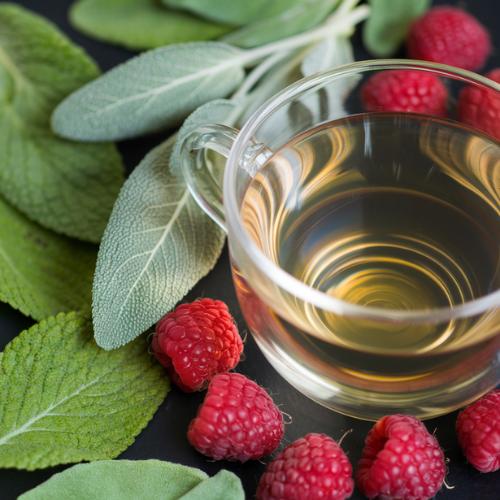
Healthy and Natural World recommend a sage tea blend not only for hot flashes but also for managing night sweats, another common menopause symptom.
Alongside sage, this recipe features raspberry leaf, a popular herb in its own right. In Menopause and Estrogen: Natural Alternatives to Hormone Replacement Therapy (1996), Ellen Hodgson Brown and Lynne Paige Walker highlight how red raspberry leaf acts as a balancing influence on hormones.
So, how do you prepare this cooling herbal tea? You’ll need:
- ½ tablespoon of fresh sage leaves (or ¼ tbsp dried)
- ½ tablespoon of fresh raspberry leaves (or ¼ tbsp dried)
Brew it in 200 ml of freshly boiled water. To sweeten the flavour, add a touch of stevia, agave nectar or maple syrup if you like.
Here’s how to make it:
- Wash the leaves and place them in your pot.
- Pour the boiling water over the herbs.
- Let the tea steep for 8-10 minutes.
- Sip a small glass every 3 hours for best results, rather than drinking it all at once.
Take note though: according to LiveStrong, the tannins in raspberry leaf may reduce iron absorption in the intestines, so it’s best to enjoy this tea away from meals.
“Tannins in raspberry leaf may reduce the absorption of iron in the intestines, so it is best to take raspberry leaf away from meals.” (Source)
Calming Hot Flashes with Sarsaparilla
Looking for an alternative to sage? Sarsaparilla might be just what you need to ease menopause symptoms.
Search Home Remedy shares a simple recipe for sarsaparilla tea. The hardest part might be finding the sarsaparilla root, depending on where you live and how well-stocked your local health store is.
According to Dr Axe, this traditional remedy from Native American and Amazonian cultures works to rebalance hormones and detox the body. It’s also been used to treat colds and skin conditions—good to know for overall wellbeing!
Here’s how to make it:
- Use 1 gram of dried sarsaparilla root.
- Add it to a cup of hot water.
- Steep for 5 minutes, then strain and enjoy.
It’s that easy!
A Cooling Herbal Blend in a Jar
Integrative wellness coach Kathy Hammonds has crafted a menopause tea recipe to help with symptoms like hot flashes. This blend combines three powerhouse herbs, making it straightforward to prepare, though you’ll need to let it steep for a while.
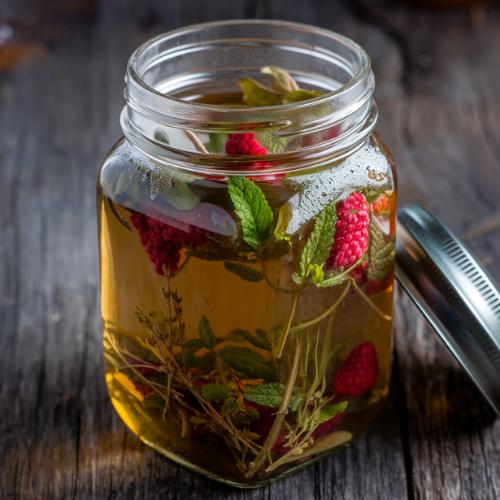
Raspberry leaf is back, and you might remember nettle tea as an unexpected remedy for menopause itching.
The third key ingredient in this recipe is red clover, which, according to the University of Michigan, may help reduce hot flashes due to its isoflavones.
“In one study, isoflavones from red clover reduced the frequency of hot flashes in postmenopausal women” (Source)
Here’s how to make this cooling herbal tea:
- ¼ cup of stinging nettle leaf
- ¼ cup of red clover
- ¼ cup of raspberry leaf
Combine the herbs in a jar—Hammonds suggests using a heatproof glass jar. Fill it up with hot water, cover with a lid, and allow it to cool for 4 hours. Once steeped, strain and serve.
A Sweet Solution for Hot Flashes
Bev of Honey Fanatic’s offers a soothing recipe for sage tea, with a delightful twist—honey.
This simple tea is quick to prepare, requiring no special equipment, and its sweet addition may help ease the discomfort of hot flashes, especially at night.
Here’s what you’ll need:
- Teapot or heatproof jug
- Strainer
- Teacup
- 8 fresh sage leaves (or 1 teaspoon dried)
- 1 cup of boiling water
- 2 teaspoons honey
- 2 teaspoons lemon juice
Step 1: Preparing the Leaves
Select and rinse 8 fresh sage leaves, or if you’re using dried sage, just 1 teaspoon will do. Place the sage in your teapot or jug. Be sure your container is suitable for hot liquids—trust me, you won’t want to be pouring this from a Pyrex bowl!
Step 2: Start Steeping
If you’re using a glass teapot, it’s best to warm it slightly before pouring in boiling water to avoid cracking. Once your teapot is ready, add one cup of boiling water over the sage leaves. Let it steep for five minutes before straining into a teacup.
Step 3: Sweet and Sour
Add the lemon juice and honey to your tea. Honey Fanatic highlights that honey is more than just a tasty addition. As you may know, hot flashes can disrupt sleep, but honey can counteract that.
“Honey, before bedtime, has a tranquilizing effect, and it contributes to overall health and well-being.” – Bev, Honey Fanatic
Step 4: Keep on Brewing
Bev recommends making this tea before bed for three nights in a row to give you a solid start. After that, drink it every few days to maintain the effects.
As always, be sure to consult a specialist to ensure this remedy is suitable for you.
What’s Brewing in Your Teacup?
According to Marie Nadine Antol, author of Healing Teas: A Practical Guide to the Medicinal Teas of the World (1996), (affiliate link) it’s important to note that sage tea shouldn’t be consumed continuously for more than three weeks. The same goes for sarsaparilla—avoid using it over a long period.
As always, everything in moderation! And most importantly, consult a healthcare professional to get advice tailored to your unique needs and health situation.
Did you enjoy these tea recipes? I hope so!
Personally, I think they not only have the potential to help but also to taste great.
Have you tried any of these blends for hot flashes? Or do you have another tea recipe that’s worked wonders for you? We’d love to hear about your experience!
Related Articles
Sage for the Menopause
How to Make your Own Tea for Hot FlashesAbout
SageBest Herbs for Menopause
How to Make Sage Tea for Menopause

